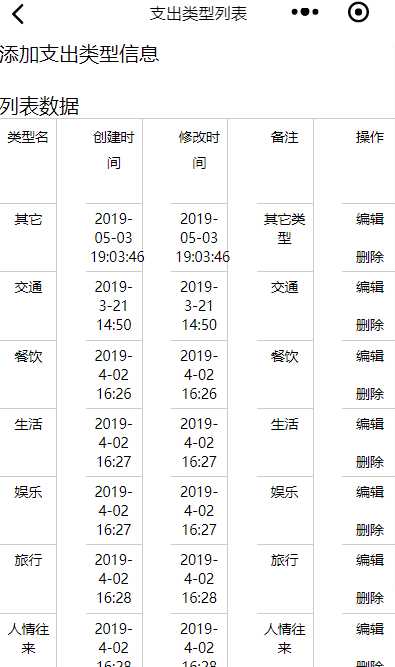微信小程序之使用wx:for遍历循环
时间:2019-07-20 23:37:13
收藏:0
阅读:570
效果图如下:

实现代码如下:
type.js:
// pages/type/type.js Page({ /** * 页面的初始数据 */ data: { types: "" }, editType: function (e) { var typeId = e.currentTarget.dataset[‘id‘]; console.log("edit:"+typeId); wx.navigateTo({ url: ‘../type_edit/type_edit?typeId=‘ + typeId }) }, delType:function(e){ var typeId = e.currentTarget.dataset[‘id‘]; console.log("delete:"+typeId) wx.showModal({ title: ‘提示‘, content: ‘确认要删除该支出类型?‘, success: function (res) { if (res.confirm) { console.log(‘用户点击确定‘) wx.request({ url: getApp().globalData.urlPath + "spendingType/delete", method: "POST", data: { typeId: typeId }, header: { "Content-Type": "application/x-www-form-urlencoded" }, success: function (res) { console.log(res.data.code); if (res.statusCode == 200) { //访问正常 if (res.data.code == "000000") { wx.showToast({ title: "删除成功,返回支出类型列表", icon: ‘success‘, duration: 3000, success: function () { wx.navigateTo({ url: ‘../type/type‘ }) } }) } } else { wx.showLoading({ title: ‘系统异常‘, fail }) setTimeout(function () { wx.hideLoading() }, 2000) } } }) } else if (res.cancel) { console.log(‘用户点击取消‘) } } }) }, /** * 生命周期函数--监听页面加载 */ onLoad: function (options) { wx.setNavigationBarTitle({ title: "支出类型列表" }) var userCode = wx.getStorageSync(‘userId‘); var self = this wx.request({ url: getApp().globalData.urlPath + "spendingType/types",//json数据地址 data: { userCode: userCode }, headers: { "Content-Type": "application/x-www-form-urlencoded" }, success: function (res) { self.setData({ types: res.data.data });//等同于 } }) }, /** * 生命周期函数--监听页面初次渲染完成 */ onReady: function () { }, /** * 生命周期函数--监听页面显示 */ onShow: function () { }, /** * 生命周期函数--监听页面隐藏 */ onHide: function () { }, /** * 生命周期函数--监听页面卸载 */ onUnload: function () { }, /** * 页面相关事件处理函数--监听用户下拉动作 */ onPullDownRefresh: function () { }, /** * 页面上拉触底事件的处理函数 */ onReachBottom: function () { }, /** * 用户点击右上角分享 */ onShareAppMessage: function () { } })
type.js没什么好说的,如果要说,只能说这个onLoad这里的onLoad就相当于js中的onload方法,当进入该视图时,默认全局加载一次。
type.wxml:
<view>
<view>
<navigator url="/pages/type_add/type_add" hover-class="navigator-hover">添加支出类型信息</navigator>
</view>
<view>
<text>\n</text>
</view>
<view>
<view>
<text>列表数据</text>
<text>\n</text>
</view>
<view class="table">
<view class="tr thead">
<view class="td">类型名</view>
<view class="td">创建时间</view>
<view class="td ">修改时间</view>
<view class="td">备注</view>
<view class="td ">操作</view>
</view>
<block>
<view class="tr" wx:for="{{types}}" wx:for-item="item">
<view class="td">{{item.typeName}}</view>
<view class="td">{{item.createDate}}</view>
<view class="td">{{item.modifyDate}}</view>
<view class="td">{{item.remark}}</view>
<view class="td">
<text bindtap=‘editType‘ data-id="{{item.typeId}}">编辑</text>
<text>\n</text>
<text>\n</text>
<text bindtap=‘delType‘ data-id="{{item.typeId}}">删除</text>
</view>
</view>
</block>
</view>
</view>
</view>
遍历循环主要使用的是wx:for。如果要类比的话,我觉得jstl跟这个神似。先来看看jstl,代码如下:
<c:forEach var="u" items="${user}"> <tr> <td>${u.cid}</td> <td>${u.cname}</td> <td>${u.age }</td> </tr> </c:forEach>
var相当于我可以任意定义一个简要字母来调用item(item相当于type.js中的data或self.setData存储的数据)。
如果你还不明白的话,可以联系到$.each,代码如下:
$.each(classroom_list, function(i, c) { rows = rows + "<tr>"; rows = rows + "<td>" + c.id + "</td>"; rows = rows + "<td>" + c.nickname + "</td>"; rows = rows + "<td><a href=‘student_submit_info.html?userId="+c.id+"‘>查看详情</a></td>"; rows = rows + "</tr>" });
type.wxss:
.table { border: 1px solid #ccc; font-size: 28rpx; background: #fff; border-right: none; } .tr{ display: flex; justify-content: space-between; } .td { text-align: center; border: 1px solid #ccc; display: inline-block; border-left: none; border-bottom: none; padding: 10rpx 1%; width: 12%; } .thead .td{ border-top: none; height: 140rpx; line-height: 50rpx; }
参考资料:
微信小程序之列表渲染
评论(0)
